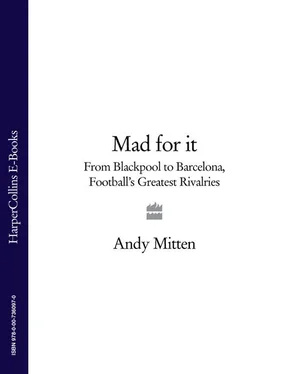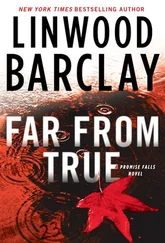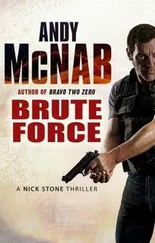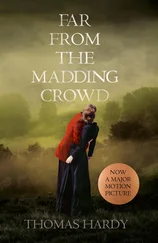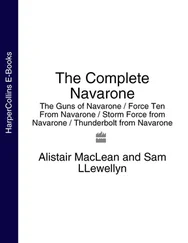To Boca’s fans, River are know as Las Gallinas (‘The Chickens’). This goes back to 1966 when River played Penarol of Uruguay in the final of the Intercontinental Cup in Montevideo. River were 2–0 up and cruising in the second half when their keeper caught the ball on his chest – puffed out like a chicken’s if you will – and proceeded to mock the opposition, who became so enraged that they lifted their game and ended up winning 4–2 after extra time. Boca have never let the River fans live it down.
Inside the ground the only people missing from the 52,000 crowds are the two sets of Barras . They prefer to make a late entrance so the other fans reserve a space for them at the centre of the middle tier. Once inside, the two sets of fans exchange taunts and sing songs – nothing new there then – but the real craze in Argentina is to jump up and down on the spot. And I mean everybody. Both sets of fans at the same time. Now Boca’s is not the most state-of-the-art ground and as the stadium shakes under the weight on 52,000 lunatics pogoing simultaneously, you wonder if it’s going to crash to the ground.
Amid the sea of yellow and blue away to our left are a surprising number of women and children, some of whom are so young they nestle in their dad’s arms as he screams his support, blood-vessels near to bursting in his forehead. As if the crowd is not fired up enough, the reserve teams of both clubs play their fixture immediately prior to the first team game. It keeps everybody entertained at least. Not that they need it.
When the fist teams finally appear they do so through an inflated tunnel, which stretches out into the centre of the pitch to prevent the players, especially those of River, being pelted with whatever the fans can get their hands on. A few bottles make their way over the tall perimeter fencing but all of them miss their targets.
As ticker tape pours down from the sky, children appear on the pitch carrying two giant flags bearing the words no mas violencia: un mensaje de Dios (‘no more violence: a message from God’). ‘It won’t be enough,’ says Pablo, as the ‘boos’ reverberate around the ground, drowning out the sound of ‘We are the World’ and ‘Imagine’, which are playing over the stadium’s public address system.
An appalling, goalless first half is lifted only by the appearance of Maradona, a former Boca star, of course, who emerges on the balcony of his box to the delight of Boca’s fans and the derision of River’s. At half time he even puts on a juggling show using a ball thrown up to him by one of the cheerleaders.
In the second half the referee, who was the best performer on the pitch in the first half, loses control of the game under intense pressure from the home crowd. He’d agreed to meet me for an interview over breakfast tomorrow morning, depending on how the game went. Needless to say, we never get the phone call. Boca, who are the better side anyway, win 3–0 after River have two men sent off. After each goal, the Boca fans, Maradona included, take off their shirts and lasso them round their heads. They’ll be going home happy and will be able to hold their heads high. At least until the two teams meet again.
In the back of Pablo’s car another River fan – also called Pablo – and a friend of Los Barrochos (though not one himself) is inconsolable. ‘I am always without hope when I come to see River play Boca, because I always feel like we’re gonna get fucked,’ he says, unable to comprehend River’s recent poor record against Boca. ‘I don’t understand it. Against teams who play good football we play beautifully and win. Then we go and lose to Boca and their shitty, ugly football.’
Still, at least nobody was killed. And with only seventy-nine arrests at the stadium, today’s Buenos Aires derby was one of the quietest.
Buenos Aires – A tale of two teams
Boca Juniors
Boca were founded in La Boca district of Buenos Aires in 1905 by Irishman Paddy McCarthy, newly arrived Italian immigrants, Pedro and Juan Feranga, and three students from the National School of Commerce – hence the name ‘Juniors’. They chose to play in the colours on the flag of the next ship to sail into port. It was a Swedish vessel – hence the yellow and blue.
Their most successful periods were the early 1930s and the late 1970s and early 1980s, when, inspired by Diego Maradona, they reached the South America Club Championship final three years in a row. Controversially, though, no Boca players were included in Argentina’s 1978 World Cup-winning squad, because of their rugged style under then manager Juan Carlos Lorenzo.
Boca have a history of bigger, more robust players, such as Gabriel Batistuta and Argentina’s 1966 World Cup captain Antonio Rattin. Even Boca’s skilful players, such as ex-stars Diego Maradona and Juan Sebastian Veron and Barcelona-bound Juan Roman Riquelme are powerfully built.
Also founded in 1905, River were formed in La Boca when two local English teams, Santa Rosa and Rosales, joined forces after playing against each other in a friendly. Both teams played in white, which caused confusion until River had the bright idea of sewing red patches on to their shirts to distinguish themselves – hence River’s colours.
The 1940s saw River and their famous forward line La Maquina (‘The Machine’) dominate the domestic game and this success continued into the 1950s with Alfredo Di Stefano to the fore. More great players followed, including Daniel Passarella and Mario Kempes.
In contrast to Boca, River have a reputation for producing stylish teams and players who fit within that framework. Current stars Ariel Ortega and Barcelona-bound starlet Javier Saviola as well as Valencia’s Pablo Aimar are classic River players.
Конец ознакомительного фрагмента.
Текст предоставлен ООО «ЛитРес».
Прочитайте эту книгу целиком, купив полную легальную версию на ЛитРес.
Безопасно оплатить книгу можно банковской картой Visa, MasterCard, Maestro, со счета мобильного телефона, с платежного терминала, в салоне МТС или Связной, через PayPal, WebMoney, Яндекс.Деньги, QIWI Кошелек, бонусными картами или другим удобным Вам способом.
